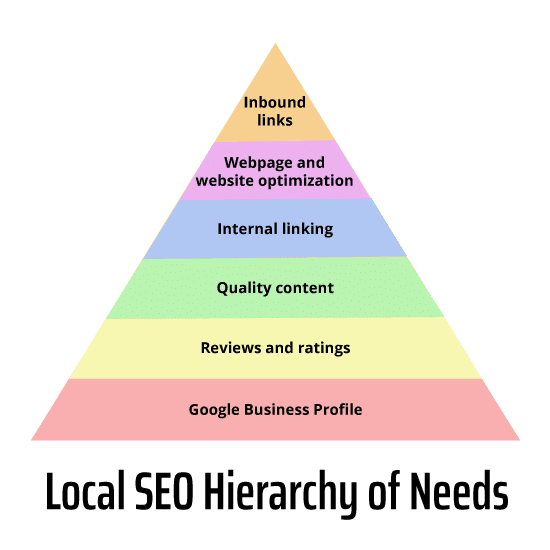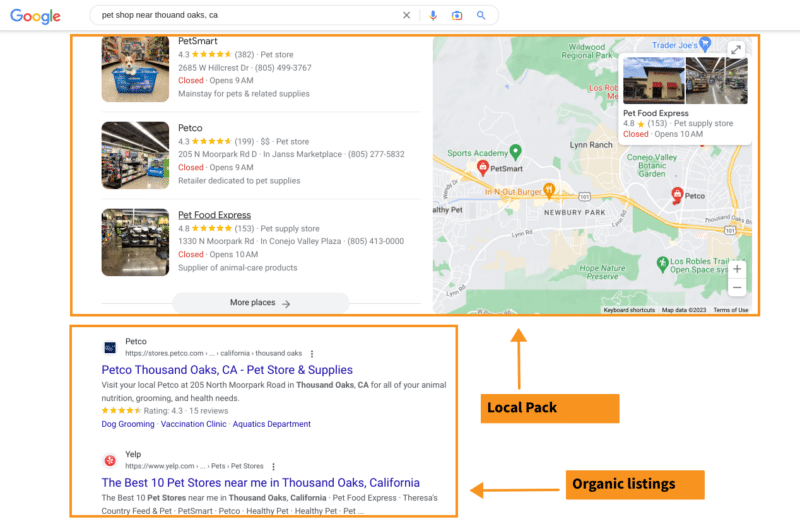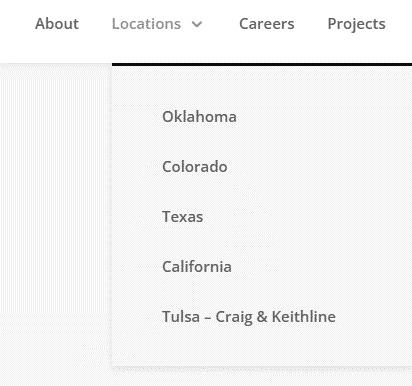The SEO hierarchy of needs for local businesses on a budget
Up to 98% of people used the internet to find information about a local business in 2022, according to BrightLocal research. And 87% of consumers used Google to evaluate a local business.
For local businesses with limited time, money and resources, it can be hard to know where to focus marketing efforts.
One thing is for sure: The ability for people to find local businesses online is critical.
And SEO is one of the most effective marketing activities for a local business to show up online, as it offers some of the best returns on investment in the long term.
Given that local businesses may have a limited budget, which SEO factors should they focus on?
Here, I’ll outline six areas that small businesses can reasonably do on their own (or spend a little money on outside help for the techie stuff) and, at the very least, get the SEO foundations in place.
What are those foundations?
For local businesses to rank in the search results, they need to consider the following areas:
- Google Business Profile
- Reviews and ratings
- Quality content
- Internal linking
- Webpage and website optimization
- Inbound links

6 SEO tactics that every local business should do at minimum
Local businesses need to focus on optimizing two areas of the search results:
- The Google local pack / local finder or Maps.
- Google organic listings.
When ranking local businesses in the local pack, Google takes into account relevance, distance and prominence.
And there is another set of countless signals it uses for the organic listings, including the “blue links.”

While the following is not an exhaustive list, it has some essential SEO tactics to do at a bare minimum for helping local business rank.
For local pack rankings
1. Google Business Profile
Creating, verifying and optimizing a Google Business Profile is one of the most critical tactics for ranking local businesses in the Local Pack.
Here are three of the most impactful optimization techniques for a Business Profile:
- Choose the most relevant primary category for the business, then add two to three categories (or only those that are most relevant). The primary category is the most important factor in helping to rank in the local pack. You may not always get it right the first time, so don’t be afraid to experiment with different categories and test the results. PlePler is a handy tool that can help in this area by providing useful data.
- Fill in the Google Business Profile as completely as possible. Take the time to fill in all the information available in a profile. Create a compelling description of the business and its offerings, using rich keywords as often as possible in a natural way.
- Ensure the business name, address, phone and website (NAP+W) are accurate. A physical address will be a key signal to Google for ranking, as it looks at businesses closest to the point of search (where the searcher is). The NAP+W data must be consistent across all sources online – not just a Google Business Profile – because it improves the search engine’s confidence in a business listing’s accuracy. Remember to use a local phone number (not a toll-free one).
2. Ratings and reviews
A local business’s ratings and reviews can impact how well it ranks, including how many reviews (text-based and numerical star ratings) and the actual scores. This is straight from Google’s mouth. So take reviews and ratings seriously.
Here are some tips:
- Encourage customers to leave reviews. Google explains how to share a link with customers to leave reviews. Doing this on an ongoing basis helps ensure the recency of reviews, which can be a positive signal to Google.
- Remember: Google doesn’t want businesses to offer incentives for leaving reviews. Many local businesses do, though. It’s a matter of ensuring that a business’s review profile represents an honest picture of the business. If all the reviews are positive with no negative reviews, then a user may not trust the business as much.
- Let customers know the business values their feedback by reading and replying to their reviews. Here’s how to read and reply to reviews on Google.
- Consider displaying third-party reviews to add value to the listing. This can further help users decide on a business.
Get the daily newsletter search marketers rely on.
See terms.
For organic rankings
3. Quality content
Quality content is probably one of – if not the most important – on-page ranking factor in most cases.
There are a lot of ways to define quality, but here are some ways to ensure it on a site:
- Study Google’s search quality rater guidelines, specifically the definitions of “experience” and “expertise” to understand how Google thinks of quality. Experience and expertise are important for local businesses to exude in their content.
- Make sure key pages throughout the site, like service pages, have enough content on them to be helpful and useful to website visitors. Spy on the top-ranked competitors for that service page’s keyword to see how much content to create.
- Outside of service pages or location pages, consider how the business will contribute to the community with content. You can establish the business as a local authority by talking about the topics the business is an expert on, telling local stories or acting as a guide. Also: Good, local content can attract good, local links.
- Have a variety of content for more opportunities to rank and be found – for example, YouTube videos, images or something else.
And remember, if you are using AI content for a website, you must have a system in place to have it reviewed and edited by a human to ensure quality.
For more, see my article on Search Engine Land: ChatGPT and SEO content: Where do we go from here?
4. Internal linking
Having a good volume of helpful content throughout the site that is organized well helps make a website more relevant for a search.
SEO siloing is a technique I invented more than 20 years ago. It structures a website’s content by grouping related webpages in hierarchical categories through its directory and links.
In other words, how you set up directories and navigation on a website matters.
Siloing streamlines the internal linking system to connect like-pages and helps the search engines discover more related content to better understand what the site is about.
It also helps users navigate with ease to find the information they need.
Remember that sometimes Google takes into account the whole website and not just a single webpage when determining which sites to rank:
“The navigation of a website is important in helping visitors quickly find the content they want. It can also help search engines understand what content the website owner thinks is important. Although Google’s search results are provided at a page level, Google also likes to have a sense of what role a page plays in the bigger picture of the site.”
– Google, Search Engine Optimization (SEO) Starter Guide
Practically, for a local business’s website, the site would most likely be organized by things like:
- A section with individual service pages.
- A section with location pages, as applicable.
For example: When a business has more than one location, create one or more pages dedicated to each location the business is in.
An example would be the siloing strategy for a keyword like “engineering firm.”
You’d create a section for locations by having a landing page for that term linked to from the top navigation. Then you’d add subpages underneath it that detail each location and the services it provides.

This would apply to every location of a business. Avoid duplicate content issues by making each location section unique.
5. Webpage and website optimization
There are countless ways to optimize a site, but for local businesses that are just getting started, here are a handful of things they can and should do to boost SEO:
- Optimize local webpages by including the city, neighborhood, relevant geographic terms and other key terms in places like the meta tags and on the webpage content, including the heading tags and anchor text.
- Implement local business-type schema on the webpages to further clarify to the search engines what the business is about and to present that information to searchers. Name, address, phone, number and website would be the minimum goal. This is a little more technical, and local businesses may want to use things like the Structured Data Markup Helper to get this going. Google also has a help file on that here.
- Optimize the performance of the website. Since most local searches are on a mobile device, local businesses must have a mobile-friendly website. This is another techie venture, but Google has tools and help files to get people started. In addition, making sure the site is secure by enabling HTTPS is key.
The last two bullets may be areas where a local business spends a little money for expert help.
6. Links
Local businesses must have quality, local links to show they are a trusted local business. Here are some ideas for earning links:
- As mentioned earlier, quality, useful content targeted to a community can earn links naturally.
- Only links coming from unique IP addresses, domains and WHOIS for a geographic area will help.
- Some more ideas to help get local links include: Joining a local organization, being listed in a local directory, hosting a local event and driving the audience to the site, sponsoring a local event, starting a blog or being interviewed by local press.
Focus on what matters
Countless SEO tactics can help local websites rank in the search results. However, there are a handful of methods where local businesses can get the most bang for their buck, whether implementing them on their own or spending some marketing budget to hire outside expertise.
Focus on the local SEO hierarchy of needs, and get the right SEO foundations in place for a chance to compete.
The post The SEO hierarchy of needs for local businesses on a budget appeared first on Search Engine Land.









Recent Comments